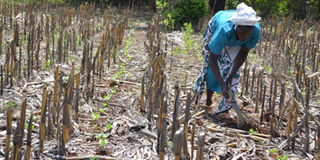More yields, low cost; what new farming system offers

Margaret Gacheke attends to her bean crops planted on untilled land after harvesting maize. Studies have shown that conservation agriculture, which Margaret currently practices, improves yields with time because the amount of organic matter and nitrogen in the soil increases gradually from season to season. PHOTO | ISAIAH ESIPISU | NATION MEDIA GROUP
What you need to know:
- Under normal farming system, the land is ploughed, and possibly ploughed again, then seeds are planted. As they germinate and grow, weeding is done where weeds are literally removed.
- The tilling method, which sees minimal penetration into the ground, has helped farmers like Margaret attain positive results for the past two seasons, and many are now getting hooked to it.
- Studies have shown that conservation agriculture improves yields with time because the amount of organic matter and nitrogen in the soil increases gradually from season to season.
James Mwenda shouts to his two oxen, commanding them to move in a straight line as they pull a ripper that slits the unploughed ground, in readiness for planting.
He reaches the end of the five acre farm in Kimate village in Imenti Central, Meru County and commands the animals to turn, before lifting the ripper and continuing to till the land.
The farm belongs to Margaret Gacheke and she is busy spreading a herbicide on another part of the unploughed farm.
Under normal farming system, the land is ploughed, and possibly ploughed again, then seeds are planted. As they germinate and grow, weeding is done where weeds are literally removed.
“Under zero tilling, which we use, the land is not ploughed at all and all the ‘former’ crop biomass is not removed, so that it forms mulch. Weeds are then killed using herbicides, then crops are planted in unploughed soil. They can be planted using a jab-planter, or shallow lines can be slit into the soil using the ripper where seeds are dropped. After the crops germinate and grow, weeds are controlled using herbicides,” explains Margaret.
The tilling method, which sees minimal penetration into the ground, has helped farmers like Margaret attain positive results for the past two seasons, and many are now getting hooked to it.
Gacheke, a mother of two plants Dolichos Lablab (njahi) and beans using the technique introduced in Kenya few years ago by the Food and Agriculture Organisation (FAO) with support from European Union. So far, smallholder farmers in eight semi-arid counties namely Meru, Tharaka-Nithi, Laikipia, Machakos, Kitui, Makueni, Kilifi and Kwale are using it.
“I was not easily convinced that zero till can work even after seeing it on demo plots. But after I tried it, I saw a huge difference during the second successive season,” said Gacheke, who first tried it on half acre in 2015, but has now scaled it to five.
Last season, she harvested 15 90kg bags of maize from an acre after using the method, up from less than 10.
IMPROVES YIELDS WITH TIME
In Tharaka West, members of Maweni Farmer Field School have grown sorghum for the past two seasons using the technique, and were able to secure a contract to supply the produce to the Kenya Breweries Ltd, which uses the cereal to make alcohol, says Stephen Simba Njagi, a member of the field school.
Studies have shown that conservation agriculture improves yields with time because the amount of organic matter and nitrogen in the soil increases gradually from season to season.
“The main reason for introducing this technique was to enable communities, particularly in dryland areas build resilience to climate stresses, increase food productivity and engage in agribusiness for income generation,” said Mercy Mulevu, the County Programme Officer for FAO in Meru County.
The secret of success with conservation agriculture also lies in embracing of good agricultural practices such as crop rotation, the use of appropriate varieties of drought tolerant crops, the use of certified seed, timely planting, correct fertiliser application an improved post-harvest storage, said Cyprian Mariene, a trained trainer in zero-till farming for communities in Imenti Central.
So far, all the zero-till gadgets that include ripper and planter purchased by FAO are kept under the custody of sub-county governments. Mulevu said most of the farmers work in groups, and it is through the outfits that they pick particular equipment from the government offices, and return them after use.
But individuals have started fabricating some of the equipment and are selling them to farmers, widening reach.
“The idea that farmers are willing to purchase some of these machines on their own is an indication that they are willing to move forward with the zero or low till farming technique,” said Mulevu.





